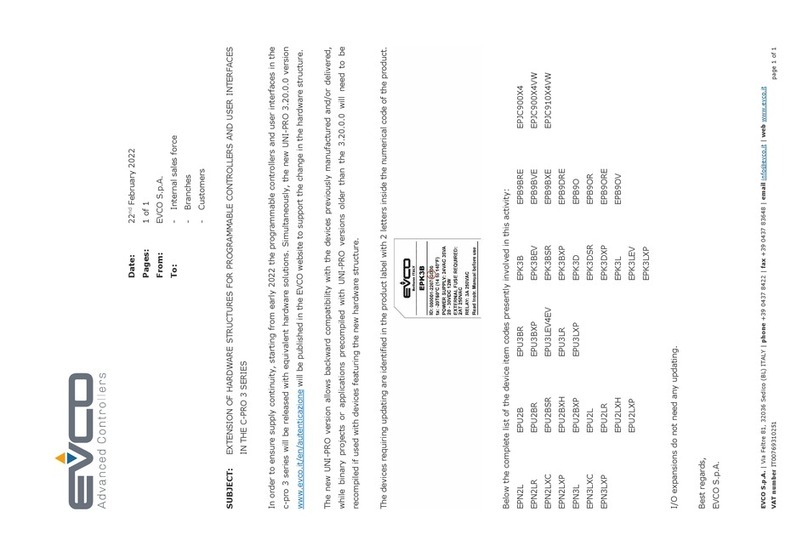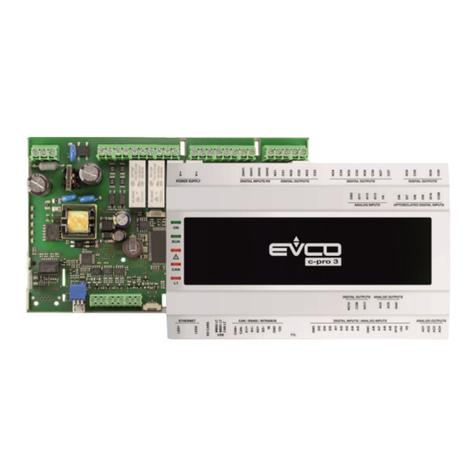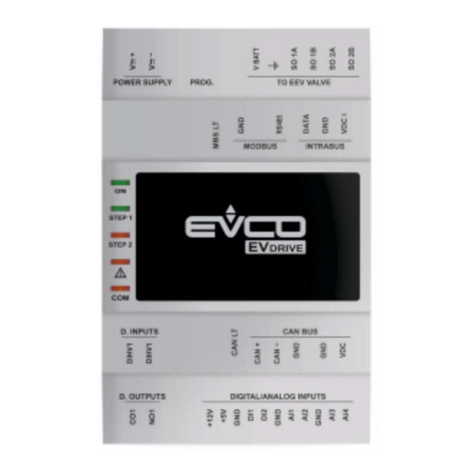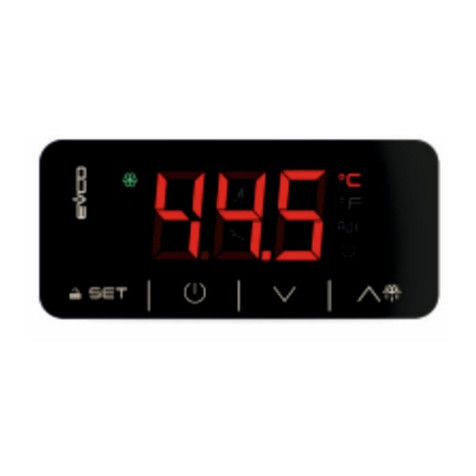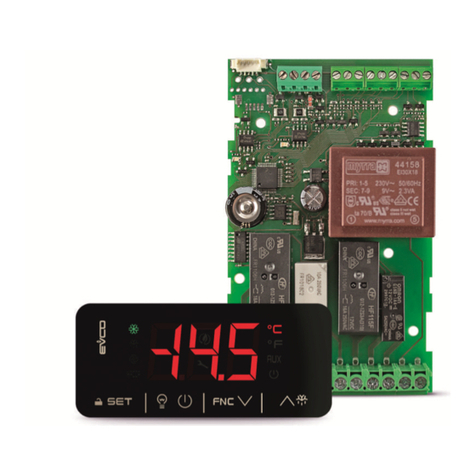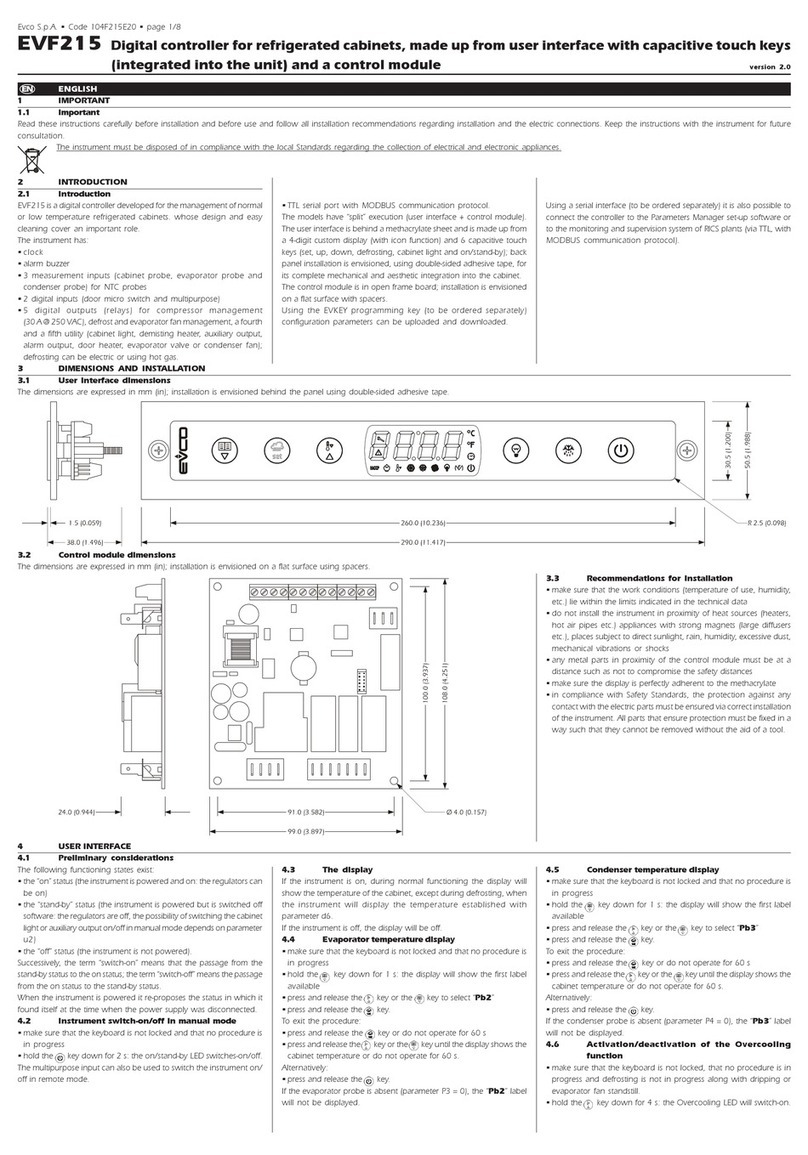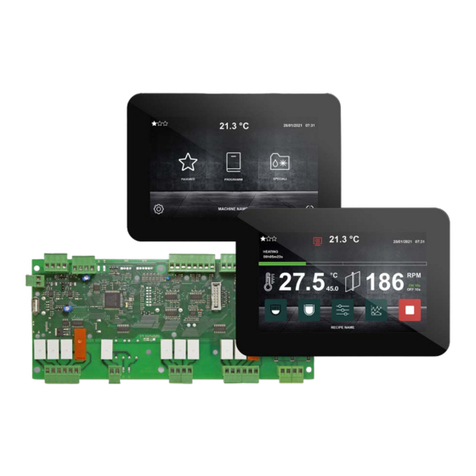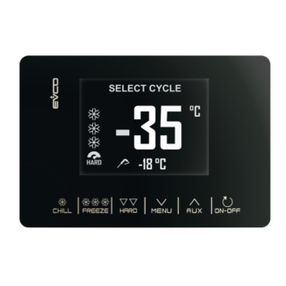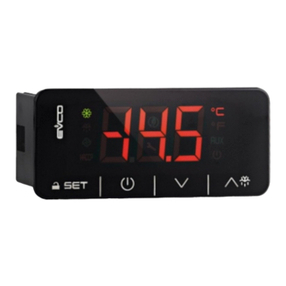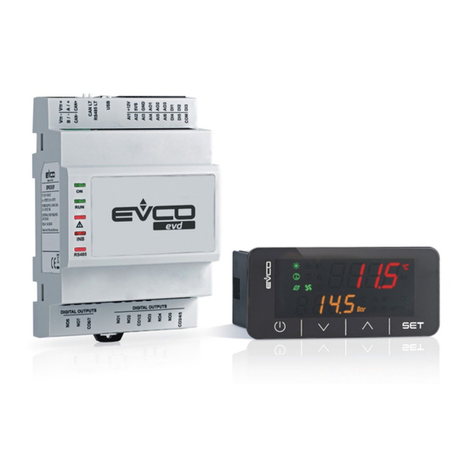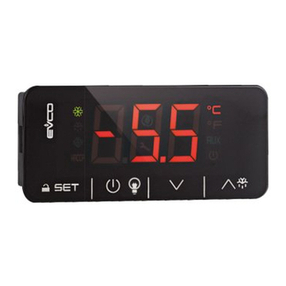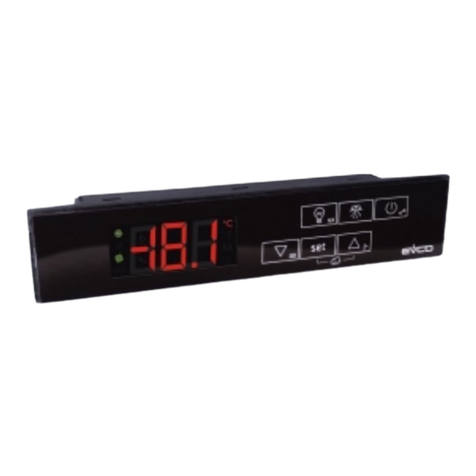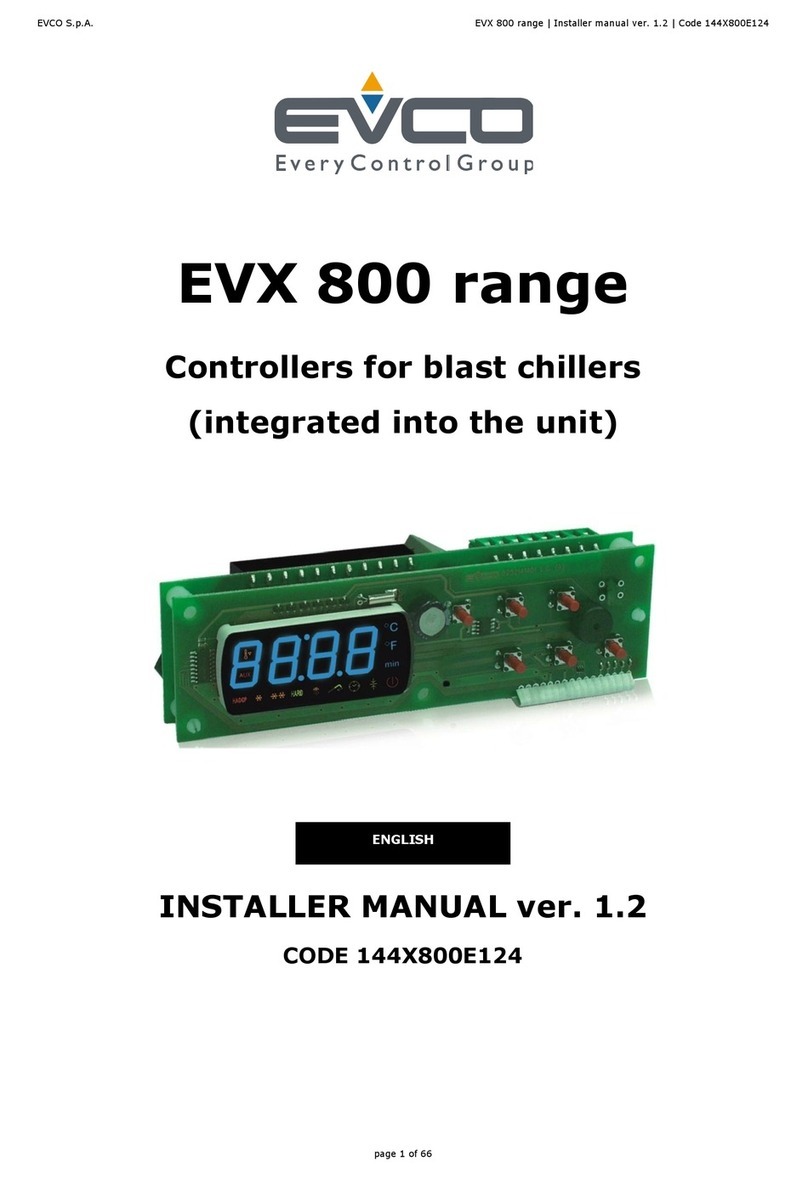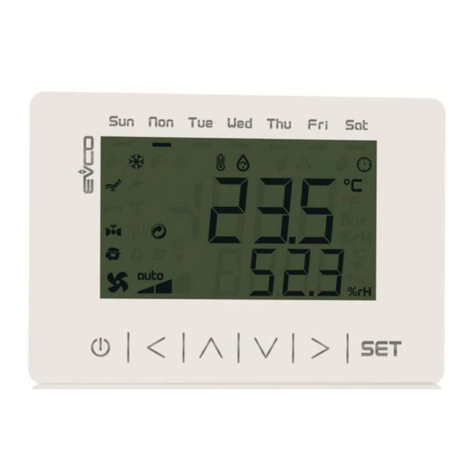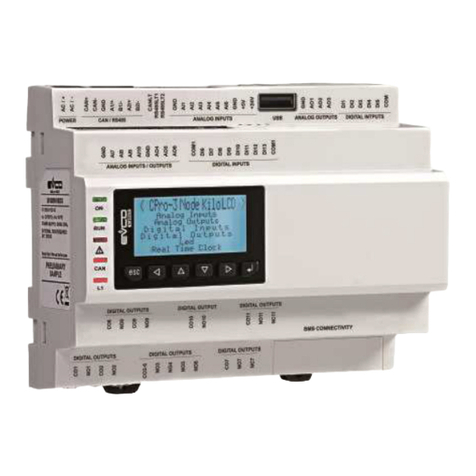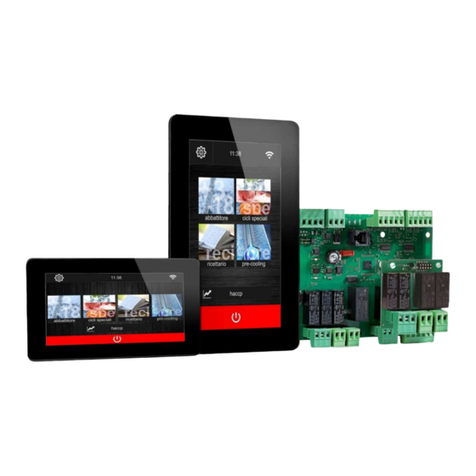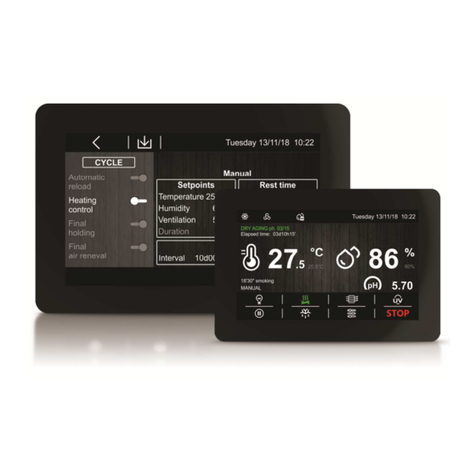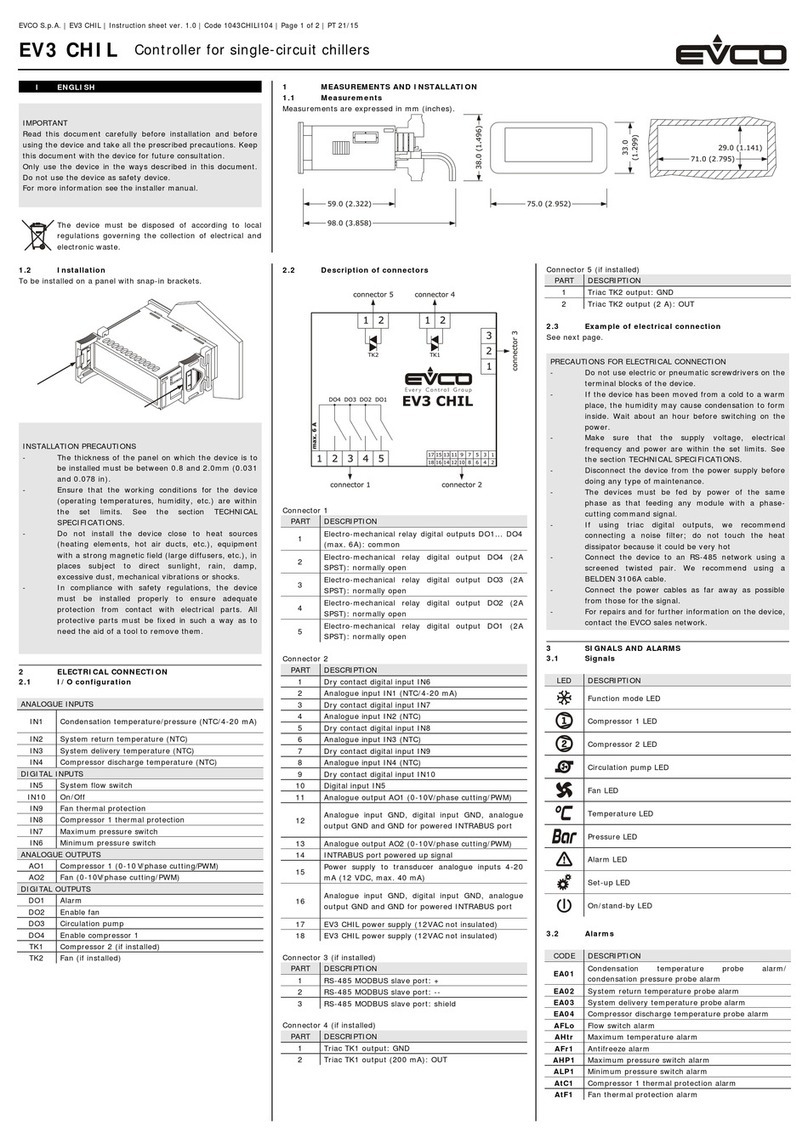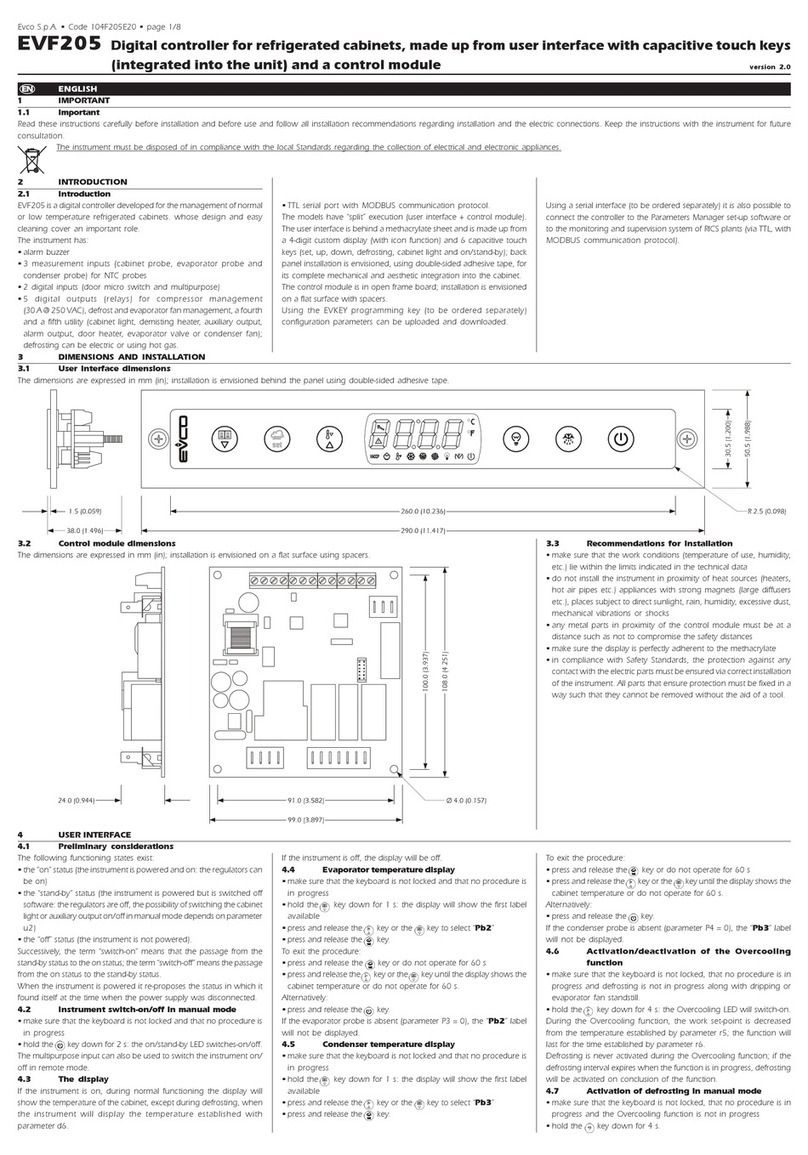
EVCOS.p.A.|EV3802|Instructionsheetver.2.0|Code1043802E203|Page2of3|PT49/20
nEG temperature controlled blast freezing and conservation
3. Touch the DOWN key again to see the cabinet temperature.
4. Touch the SET key (or take no action for 15 s) to exit the proce-
dure.
After a power failure during a cycle, the cycle is automatically reactivated from the phase it was
in at the moment the power failed. If power fails during blast chilling/freezing, it is reactivated
from the beginning.
5.4 Activating the last cycle carried out
Check that the keypad is not locked and that defrosting is not active.
1. Touch the START/STOP key for 2 s.
2.
Touch the START/STOP key within 60 s: the display will show the
duration of the time controlled blast chilling/freezing or the prod-
uct temperature at the end of the temperature controlled blast
chilling/freezing.
3. Touch the SET key.
4. Touch the UP or DOWN key within 15 s to set the value.
5. Touch the SET key (or take no action for 15 s).
6. Touch the START/STOP key again within 15 s.
The settings are temporary: when a new cycle is activated (and after a power failure), the de-
vice will restore the r1/r2 and r3/r4 values.
5.5 Interrupting an operating cycle
Check that the keypad is not locked.
1. Touch the START/STOP key for 2 s.
6 ADDITIONAL FUNCTIONS
6.1 Viewing compressor and evaporator fan status
Check that the keypad is not locked.
1. Touch the DOWN key once (to view compressor status) or twice
(to view evaporator fan status).
LAB. MEANING FOR COMPRESSOR
C-1 compressor on
C-0 compressor off
C-P compressor protection in progress
LAB. MEANING FOR EVAPORATOR FANS (if u0 = 1)
F-1 evaporator fans on
F-0 evaporator fans off
F-P evaporator fan delay in progress
2. Touch the SET key (or take no action for 15 s) to exit the proce-
dure.
7 SETTINGS
7.1 Setting first level configuration parameters
1. Touch the SET key for 4 s: the display will show the label “PA”.
2. Touch the UP or DOWN key to select a parameter.
3. Touch the SET key.
4. Touch the UP or DOWN key within 15 s to set the value.
5. Touch the SET key (or take no action for 15 s).
6. Touch the SET key for 4 s (or take no action for 60 s) to exit the
procedure.
7.2 Setting second level configuration parameters
1. Touch the SET key for 4 s: the display will show the label “PA”.
2. Touch the SET key.
3. Touch the UP or DOWN key within 15 s to set the PAS value (de-
fault “-19”).
4. Touch the SET key (or take no action for 15 s): the display will
show the label “CA1”.
5. Touch the UP or DOWN key to select a parameter.
6. Touch the SET key.
7. Touch the UP or DOWN key within 15 s to set the value.
8. Touch the SET key (or take no action for 15 s).
9. Touch the SET key for 4 s (or take no action for 60 s) to exit the
procedure.
7.3 Restoring factory (default) settings and saving customised settings
N.B.
- check that the factory settings are appropriate; see the section CONFIGURATION
PARAMETERS.
- saving customised settings overwrites the factory settings.
1. Touch the SET key for 4 s: the display will show the label “PA”.
2. Touch the SET key.
3. Touch the UP or DOWN key within 15 s to set the value.
VAL. MEANING
149 value for restoring the factory information (default)
161 value for saving customised settings
4.
Touch the SET key (or take no action for 15 s): the display will
show the label “dEF” (for setting the “149” value) or the label
“MAP” (for setting the “161” value).
5. Touch the SET key.
6. Touch the UP or DOWN key within 15 s to set “4”.
7.
Touch the SET key (or take no action for 15 s): the display will
show “- - -” flashing for 4 s, after which the device will exit the
procedure.
8. Disconnect the device from the power supply.
9. Touch the SET key for 2 s before action 6 to exit the procedure
beforehand.
8 CONFIGURATION PARAMETERS
8.1 First level parameters
NO.
PAR. DEF. REGULATION MIN... MAX.
8 r0 2.0 r7, r8, r9 and rA differential 1... 15 °C/°F
9
r1
90
duration time controlled blast
chilling 1... 600 min
10
r2
240
duration time controlled blast
freezing 1... 600 min
11
r3
3.0
product temperature at end of
temperature controlled blast
chilling
-99... 99 °C/°F
12
r4
-18.0
product temperature at end of
temperature controlled blast
freezing
-99... 99 °C/°F
13
r5
90
maximum duration temperature
controlled blast chilling 1... 600 min
14
r6
240
maximum duration temperature
controlled blast freezing 1... 600 min
15
r7
0.0
cabinet setpoint during blast
chilling -99... 99 °C/°F
16
r8
-40.0
cabinet setpoint during blast
freezing -99... 99 °C/°F
17
r9
2.0
cabinet setpoint during conserva-
tion after blast chilling -99... 99 °C/°F
18
rA
-20.0
cabinet setpoint during conserva-
tion after blast freezing -99... 99 °C/°F
8.2 Second level parameters
NO.
PAR. DEF. ANALOGUE INPUTS MIN... MAX.
1 CA1 0.0 cabinet probe offset -25... 25 °C/°F
2 CA2 0.0 needle probe offset -25... 25 °C/°F
3 P0 1 type of probe 0 = PTC 1 = NTC
4 P1 1 enable decimal point °C 0 = no 1 = yes
5 P2 0 temperature measurement unit 0 = °C 1 = °F
6 P3 1 enable needle probe 0 = no 1 = yes
7 P8 5 display refresh time 0... 250 s : 10
NO.
PAR. DEF. REGULATION MIN... MAX.
8 r0 2.0 r7, r8, r9 and rA differential 1... 15 °C/°F
9
r1
90
duration time controlled blast
chilling 1... 600 min
10
r2
240
duration time controlled blast
freezing 1... 600 min
11
r3
3.0
product temperature at end of
temperature controlled blast
chilling
-99... 99 °C/°F
12
r4
-18.0
product temperature at end of
temperature controlled blast
freezing
-99... 99 °C/°F
13
r5
90
maximum duration temperature
controlled blast chilling 1... 600 min
14
r6
240
maximum duration temperature
controlled blast freezing 1... 600 min
15
r7
0.0
cabinet setpoint during blast
chilling -99... 99 °C/°F
16
r8
-40.0
cabinet setpoint during blast
freezing -99... 99 °C/°F
17
r9
2.0
cabinet setpoint during conserva-
tion after blast chilling -99... 99 °C/°F
18
rA
-20.0
cabinet setpoint during conserva-
tion after blast freezing -99... 99 °C/°F
19
rb
1
type of cycle enabled
0 = blast chilling and con-
servation
1 = blast chilling/freezing
and conservation
2 = blast freezing and con-
servation
20
rc
5.0
minimum gap to pass first phase
of needle probe test
0... 99 °C/°F
0 = disabled
first phase ok if [(needle
temperature - cabinet tem-
perature) > rc] 3 times out of
5, checked every 10 s
21
rd
60
duration second phase needle
probe test
1... 99 s
second phase ok if [(needle
temperature - cabinet tem-
perature) > 1 °C/°F] 6 times
out of 8 (compared to previ-
ous test), checked every
(rd/8) s
NO.
PAR. DEF. COMPRESSOR MIN... MAX.
22
C0
3
compressor-on delay from cycle
activation and power-on 0... 240 min
23
C1
5
delay between two compressor
switch-ons 0... 240 min
24
C2 3 minimum compressor-off time 0... 240 min
25
C3 0 minimum compressor-on time 0... 240 s
26
C4
10
compressor-off time in cabinet
probe alarm during conservation 0... 240 min
27
C5
10
compressor-on time in cabinet
probe alarm during conservation
after blast chilling
0... 240 min
28
C6
20
compressor-on time in cabinet
probe alarm during conservation
after blast freezing
0... 240 min
29
C11
0
needle probe function in event of
cabinet probe error
0 = needle probe
1 = needle probe and cabi-
net probe
NO.
PAR. DEF. DEFROST MIN... MAX.
30
d0
8
automatic defrost interval
0... 99 h
0 = manual only
31
d3 30 defrost duration 0... 99 min
32
d7 2 dripping time 0... 15 min
NO.
PAR.
DEF.
ALARMS (active during conserva-
tion) MIN... MAX.
33
A1
10.0
low temperature alarm threshold
(relative to r9 and rA)
0... 99 °C/°F
r9 - A1 and rA - A1
differential = 2 °C/4 °F
34
A2 1 enable low temperature alarm 0 = no 1 = yes
35
A4
10.0
high temperature alarm thresh-
old (relative to r9 and rA)
0... 99 °C/°F
r9 + A4 and rA + A4
differential = 2 °C/4 °F
36
A5 1 enable high temperature alarm 0 = no 1 = yes
37
A6
15
high/low temperature alarm de-
lay from conservation 0... 240 min
38
A7
15
high/low temperature alarm de-
lay 0... 240 min
39
A8
15
high temperature alarm delay
post-defrosting 0... 240 min
40
A9
15
high temperature alarm delay
from door closure 0... 240 min
if i0 = 0 or 1
41
AA
5
buzzer duration after blast
chilling/freezing 0... 240 s
NO.
PAR.
DEF.
EVAPORATOR FANS (always on
during defrosting) MIN... MAX.
42
F0
2
evaporator fan mode during blast
chilling/freezing 0 = off 1 = on
2 = on if compressor on
43
F2
1
evaporator fan mode during con-
servation 0 = off 1 = on
2 = on if compressor on
44
F8
0
evaporator fan delay from de-
frost activation 0... 99 min
NO.
PAR. DEF. DIGITAL INPUTS MIN... MAX.
45
i0
1
door switch/multi-purpose input
function
0 = evaporator fans off
1 = compressor + evapora-
tor fans off
2 = alarm iA
3 = after 10 s evaporator
fans off
4 = after 10 s compressor +
evaporator fans off
46
i1
0
activation door switch/multi-
purpose input
0 = with contact closed
1 = with contact open
2 = disabled
47
i2
30
door open alarm delay
-1... 120 min
-1 = disabled
if i0 = 0 or 1
48
i3
15
maximum time for inhibiting reg-
ulation with door open
-1... 120 min
-1 = until closed
if i0 = 0 or 1
49
i7
0
compressor-on delay from multi-
purpose input alarm reset -1... 120 min
-1 = disabled
NO.
PAR. DEF. DIGITAL OUTPUTS MIN... MAX.
50
u0
0
auxiliary output configuration
0 = defrosting
1 = evaporator fans
N. PAR. DEF. DATA-LOGGING EVLINK MIN... MAX.
51
Hr0 - unused -
52
bLE
1
serial port configuration for con-
nectivity
0 = free
1 = forced for EVconnect or
EPoCA
2-99= EPoCA local network
address
53
rE0 15 data-logger sampling interval 0... 240 min
NO.
PAR. DEF. MODBUS MIN... MAX.
52
LA 247 MODBUS address 1... 247
53
Lb
2
MODBUS baud rate
0 = 2,400 baud
1 = 4,800 baud
2 = 9,600 baud
3 = 19,200 baud
54
LP
2
MODBUS parity
0 = none 1 = odd
2 = even
NO.
PAR. DEF. MODBUS MIN... MAX.
55
E0
247
quick setting of value during cy-
cle activation
0 = disabled
1 = duration of time con-
trolled blast
chilling/freezing or
product temperature at
end of temperature con-
trolled blast
chilling/freezing
2 = duration of time con-
trolled blast
chilling/freezing and/or
cabinet setpoint during
blast chilling/freezing
3 = duration of time con-
trolled blast
chilling/freezing and
cabinet setpoint during
blast chilling/freezing or
product temperature at
end of temperature con-
trolled blast
chilling/freezing and
cabinet setpoint during
blast chilling/freezing
56
E9 - unused -
NO.
PAR. DEF. SECURITY MIN... MAX.
57
PAS -19 password -99... 999
58
PA1 426 level 1 password -99... 999
59
PA2 824 level 2 password -99... 999
9 ALARMS
CODE
MEANING RESET TO CORRECT
Pr1 cabinet probe alarm automatic - check P0
Pr2 needle probe alarm automatic - check integrity of the probe
- check electrical connection
AL low temperature alarm automatic check A1 and A2
AH high temperature alarm automatic check A4 and A5
id door open alarm automatic check i0 and i1
iA multi-purpose input alarm automatic check i0 and i1
10 TECHNICAL SPECIFICATIONS
Purpose of the control device: function controller.
Construction of the control device: built-in electronic device.
Housing: black, self-extinguishing.
Category of heat and fire resistance: D.
Measurements:
75.0 x 33.0 x 59.0 mm (2 15/16 x 1 5/16 x
2 5/16 in) with fixed screw terminal blocks 75.0 x 33.0 x 81.5 mm (2 15/16 x 1 5/16 x
3 3/16 in) with plug-in screw terminal blocks
Mounting methods for the control device:
to be fitted to a panel, snap-in brackets pro-
vided
Degree of protection provided by the casing: IP65 (front).
Connection method:
fixed screw terminal blocks for
wires up to 2.5 mm²
plug-in screw terminal blocks
for wires up to
2.5 mm² (on request)
Pico-Blade connector.
Maximum permitted length for connection cables:
power supply: 10 m (32.8 ft) analogue inputs: 10 m (32.8 ft)
digital inputs: 10 m (32.8 ft) digital outputs: 10 m (32.8 ft).
Operating temperature: from 0 to 55 °C (from 32 to 131 °F)
Storage temperature: from -25 to 70 °C (from -13 to 158 °F).
Operating humidity:
relative humidity without condensate from
10 to 90%.
Pollution status of the control device: 2.
Compliance:
RoHS 2011/65/EC
WEEE 2012/19/EU
REACH (EC) Regulation
no. 1907/2006
EMC 2014/30/EU LVD 2014/35/EU.
Power supply:
230 VAC (+10% -15%), 50/60 Hz (±3 Hz),
max. 2 VA insulated in EV3... N7 115 VAC (+10% -15%), 50/60 Hz (±3 Hz),
max. 2 VA insulated in EV3... N5.
Earthing methods for the control device: none.
Rated impulse-withstand voltage: 4 KV.
Over-voltage category: III.
Software class and structure: A.
Analogue inputs:
2 for PTC or NTC probes (cabinet probe and
needle probe).
PTC probes: Type of sensor: KTY 81-121 (990 @ 25 °C, 77 °F)
Measurement field: from -50 to 150 °C (from -58 to 302 °F)
Resolution: 0.1 °C (1 °F).
NTC probes: Type of sensor: ß3435 (10 K@ 25 °C, 77 °F)
Measurement field: from -40 to 105 °C (from -40 to 221 °F)
Resolution: 0.1 °C (1 °F).
Digital inputs: 1 dry contact (door switch/multi-purpose).
Dry contact: Type of contact: 5 VDC, 1.5 mA
Power supply: none
Protection: none.
Digital outputs:
2 with electro-mechanical relay (compressor and auxiliary
relay).
Compressor relay (K1): SPST, 16 A res. @ 250 VAC
Auxiliary relay (K2): SPDT, 8 A res. @ 250 VAC.
Type 1 or Type 2 actions: type 1.
Additional features of Type 1 or Type 2 ac-
tions: C.
Displays: custom display, 3 digit, with function icons.
Alarm buzzer: built-in.
Communications ports:
1 TTL MODBUS slave port for EVconnect app,
EPoCA remote monitoring system or for
BMS.
